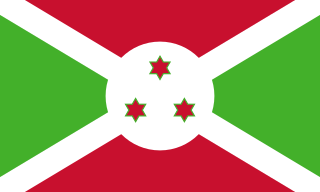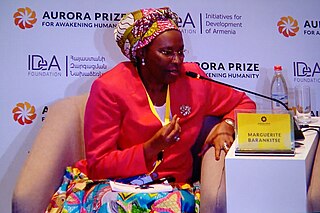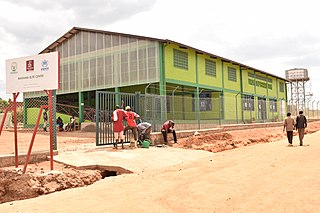
Burundi originated in the 16th century as a small kingdom in the African Great Lakes region. After European contact, it was united with the Kingdom of Rwanda, becoming the colony of Ruanda-Urundi - first colonised by Germany and then by Belgium. The colony gained independence in 1962, and split once again into Rwanda and Burundi. It is one of the few countries in Africa to be a direct territorial continuation of a pre-colonial era African state.

Kirundo Province is one of the eighteen provinces of Burundi, in north of the country bordering Rwanda. The economy is mostly based on agriculture, with a dispersed population and few sizable communities. Before 1970 large parts of the province were forested. Migrants from the south then cleared much of the vegetation to create agricultural land, and Kirundo became the breadbasket of Burundi. The civil war from 1993 to 2005 caused agricultural output to drop by more than half. Sice then, lack of farm inputs, poor infrastructure and shortages of water have caused widespread poverty.

The Burundian Civil War was a civil war in Burundi lasting from 1993 to 2005. The civil war was the result of longstanding ethnic divisions between the Hutu and the Tutsi ethnic groups. The conflict began following the first multi-party elections in the country since its independence from Belgium in 1962, and is seen as formally ending with the swearing-in of President Pierre Nkurunziza in August 2005. Children were widely used by both sides in the war. The estimated death toll stands at 300,000.

Marguerite (Maggie) Barankitse is a Burundian humanitarian activist who works to improve the welfare of children and challenge ethnic discrimination in Burundi. After rescuing 25 children from a massacre, she was forced to witness the conflicts between the Hutu and Tutsi in her country in 1993. She established Maison Shalom, a shelter that provided access to healthcare, education, and culture to over 20,000 orphan children in need. Because she protested against a third term for President Pierre Nkurunziza, she lives in exile.

Safiatou Thiam is a Senegalese public health doctor, a specialist in HIV/AIDS and former Minister of Health and Disease Prevention in the government of Cheikh Hadjibou Soumaré.She later became Executive Secretary of CNLS National Council against AIDS
The commune of Bugabira is a commune of Kirundo Province in northern Burundi. The capital is Bugabira. There are health centers at Muyange and Ruhehe.
Busoni is a commune of Kirundo Province in northern Burundi. The seat lies at Busoni.
The Commune of Bwambarangwe is a commune of Kirundo Province in northern Burundi.
Burundi–Tanzania relations are bilateral relations between Burundi and Tanzania. Burundi is a strategic partner of Tanzania in many areas, particularly trade. Since Burundi is a landlocked country, almost 80% of its goods are moved through by road to Dar es Salaam Port. Tanzania has also been a strategic partner in mediating the political tensions in the country. Both countries are members of the African Union.
Alain Tribert Mutabazi is a Burundian politician who was the governor of northern Province of Kirundo and later was appointed Minister of Defense.

Mahama Refugee Camp is a refugee camp in Kirehe District in the Eastern Province of Rwanda, near the Kagera River which is the border with Tanzania. In 2016, it had over 50,000 residents, making it the size of one of Rwanda's ten largest cities. In 2021, there were over 100,000 refugees in Rwanda and most of them were here. In 2023 the population was over 58,000 with the majority under the age of 18.
Mo-Mamo Karerwa is a Burundian educator, school administrator, and politician. Trained as a teacher, when ethnic violence broke out in 1993, she founded the Magarama II Peace Primary School. The curricula of the school, which taught students from the age two through sixth grade, followed the government mandated courses for half of the day and taught conflict resolution and how to live in peace for the remainder of the school day. She developed a curriculum which taught children's rights and examined Burundian history and culture as a path to a peaceful future. The curriculum was adopted by sixteen schools in the Gitega Province and she was appointed as the primary school teacher representative to the Provincial Education Council in 2003.
The Murehe Forest is an area of forest in the north of the Kirundo Province of Burundi. It is protected by the Murehe Reserve, part of the Lacs du Nord Aquatic Landscape.
Kabanga is a village and a colline in the Commune of Busoni, Kirundo Province, Burundi.
Mugendo is a village in the Commune of Ntega, Kirundo Province in the north of Burundi.
Réverien Nzigamasabo is a politician who was governor of Kirundo Province, Burundi, from 2010 to 2015.
Nyamabuno Marsh is a marsh in the northeast of Kirundo Province, Burundi.
Melchior Nankwahomba was a politician who was appointed governor of Kirundo Province in 2015.
Rutare is a village of the Commune of Kirundo, in the Kirundo Province of Burundi.
Muyange is a village in Bugabira Commune, Kirundo Province, Burundi.






